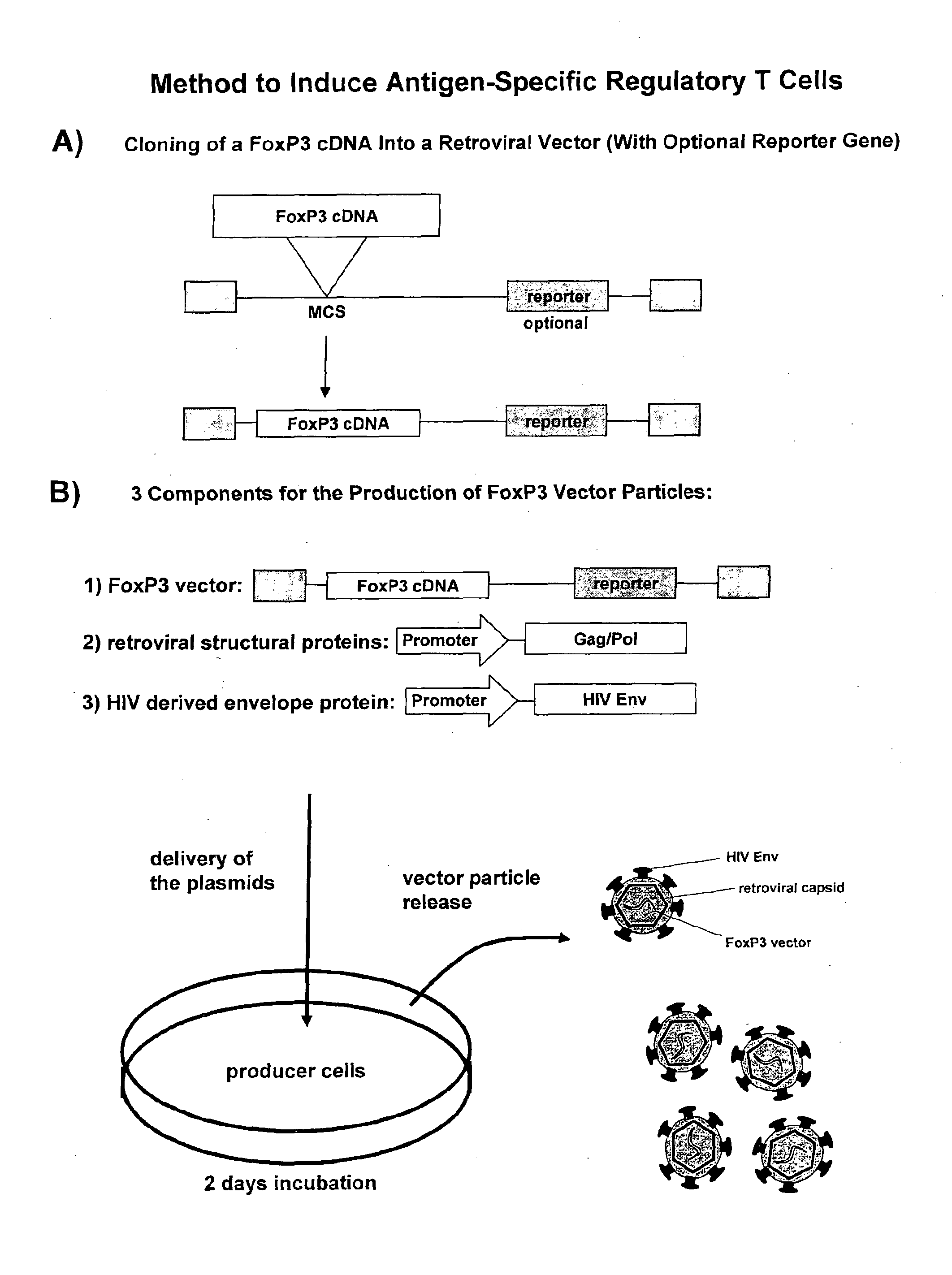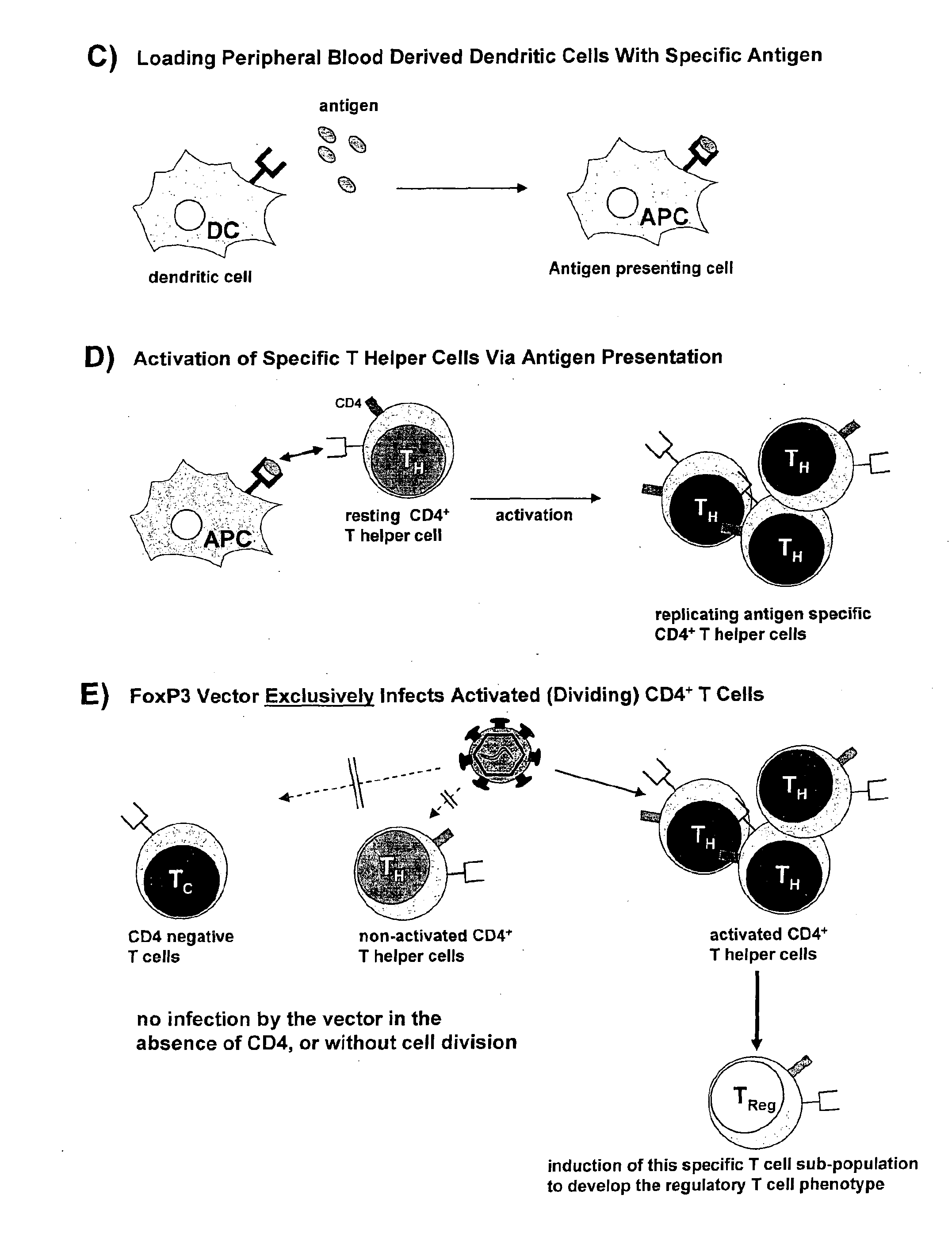Antigen-specific regulatory t-cell induction
a t-cell, antigen-specific technology, applied in the field of specific infectious particles, can solve the problems of inability to achieve general weakening of the immune system, inability to efficiently use t-cells, and inability to achieve effective therapeutic intervention
- Summary
- Abstract
- Description
- Claims
- Application Information
AI Technical Summary
Benefits of technology
Problems solved by technology
Method used
Image
Examples
example 1
[0109]FoxP3 Transferring Infectious Particles
[0110]For the targeted infection of CD4+ T cells, an MLV vector system is pseudotyped with heterologous envelope proteins. More specifically, the HIV region encoding the HIV envelope protein (HIV Env) is substituted for that of the MLV so that the MLV vector particles embody an HIV envelope. Retroviral vector particles are produced by transient transfection of human embryonic kidney cells, namely HEK293T cells stably expressing LZRNL with plasmids encoding (1) the FoxP3 expressing retroviral vector, (2) the structural and enzymatic proteins Gag / Pol of murine leukemia virus and (3) a C-terminally truncated envelope protein (Env) of human immunodeficiency virus (HIV).
[0111](1) FoxP3 Expressing Retroviral Vector[0112]The human FoxP3 sequence is accessible from the Genbank file NM—014009. To obtain FoxP3 cDNA, CD4+ T cells were first isolated from donor blood samples according to standard procedures, most preferably using the commercial MACS®...
example 2
Isolation of Dendritic Cells
[0120]Monocyte-derived dendritic cells were prepared by induction of monocyte differentiation into dendritic cells (DC). Accordingly, peripheral blood monocytes were isolated from the same blood samples as the T cells through standard cell separation methods. Specifically, CD14+ monocytes were sourced from Ficoll-Paque (GE Healthcare) preparations of peripheral blood mononuclear cells (PBMCs), followed by purification with either the commercial MACS® cell separation system available from Miltenyi Biotec or a technique involving plating of the monocytes.
[0121]The T-depleted monocytes obtained from the Ficoll-Paque isolation procedure were subjected to treatment with a CD14-specific antibody bound to MACS® microbeads, whilst maintaining the cells in RPM! 1640 medium supplemented with 10% FCS, 100 U / mL penicillin and 100 μg / mL streptomycin. Loading of the mixture of labelled and unlabelled cells upon a MACS® column, followed by subsequent elution in the pres...
example 3
[0128]Mixed Leukocyte Reaction
[0129]The medium that was used was the same mixture as described before for T cell culture. T cell-enriched fractions were obtained from PBMC prepared from buffy-coats or leukaphereses. T cells were used at a concentration of 2×106 cells / mL, DCs were used at a concentration of 2×105 cells / mL. A ratio of 30:1 of T cells to DCs and dilution series thereof were performed. T cells without DCs served as a control [J. Immunol. Meth. (2003) 277, 1].
PUM
 Login to View More
Login to View More Abstract
Description
Claims
Application Information
 Login to View More
Login to View More - R&D
- Intellectual Property
- Life Sciences
- Materials
- Tech Scout
- Unparalleled Data Quality
- Higher Quality Content
- 60% Fewer Hallucinations
Browse by: Latest US Patents, China's latest patents, Technical Efficacy Thesaurus, Application Domain, Technology Topic, Popular Technical Reports.
© 2025 PatSnap. All rights reserved.Legal|Privacy policy|Modern Slavery Act Transparency Statement|Sitemap|About US| Contact US: help@patsnap.com



